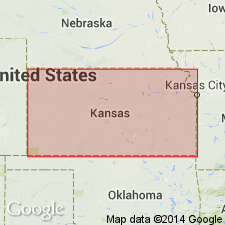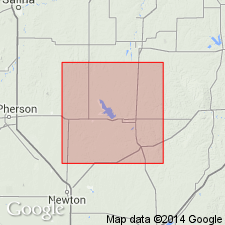
- Usage in publication:
-
- Highland shale member
- Modifications:
-
- Original reference
- Dominant lithology:
-
- Shale
- AAPG geologic province:
-
- Forest City basin
Summary:
Pg. 5-6. Highland shale member of Wellington formation. Consists of soft clay, predominately greenish, and a few thin beds of claystone. Red clays infrequent in north, more frequent to south. Approximately 45 feet thick. Underlies Slate Creek limestone member (new); overlies Carlton limestone member. Age is Permian.
Type locality: Highland Twp., in T. 22 S., R. 1 E., [Doniphan Co.], central KS.
Source: US geologic names lexicon (USGS Bull. 1200, p. 1758).

- Usage in publication:
-
- Highland shale member
- Modifications:
-
- Areal extent
- AAPG geologic province:
-
- Sedgwick basin
Summary:
Pg. 78, 81, pl. 4. Highland shale member of Wellington formation of Sumner group. In Marion County, central Kansas, consists of gray-green, maroon, and red thin-bedded clayey shale. Thickness about 40 feet. Underlies Slate Creek shale member and overlies Carlton limestone member, both of Wellington. Age is Permian.
Measured section in stream bank, in SE/4 SE/4 sec. 8, T. 17 S., R. 2 E., Marion Co., central KS; thickness 10 feet.
Source: Publication.
For more information, please contact Nancy Stamm, Geologic Names Committee Secretary.
Asterisk (*) indicates published by U.S. Geological Survey authors.
"No current usage" (†) implies that a name has been abandoned or has fallen into disuse. Former usage and, if known, replacement name given in parentheses ( ).
Slash (/) indicates name conflicts with nomenclatural guidelines (CSN, 1933; ACSN, 1961, 1970; NACSN, 1983, 2005, 2021). May be explained within brackets ([ ]).

